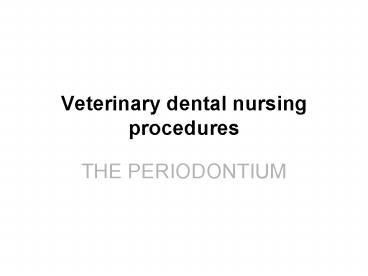Veterinary dental nursing procedures - PowerPoint PPT Presentation
1 / 52
Title:
Veterinary dental nursing procedures
Description:
Title: Veterinary Dental Nursing Author: Norbert Fischer Last modified by: Norbert Fischer Created Date: 2/17/2004 11:25:37 AM Document presentation format – PowerPoint PPT presentation
Number of Views:304
Avg rating:3.0/5.0
Title: Veterinary dental nursing procedures
1
Veterinary dental nursing procedures
- THE PERIODONTIUM
2
The Periodontium
3
Periodontium
- (tissue) next to the tooth
- Comprises
- Gingiva
- Periodontal ligament
- Tooth socket (alveolar) bone
4
Periodontitis
- Inflammation of the periodontium
5
The Gingiva
Oral mucosa
Gingival mucosa
Muco-Gingival Junction
6
Periodontium
7
Attached Gingiva
8
Muco-Gingival Junction
9
Free Gingiva
10
Gingival pocket (sulcus)
Dog 0.5-3mm
Cat 0.5-1mm
11
Junctional epithelium
attachment epithelium
12
Cemento-Enamel Junction
Visible as a line which demarcates the shiny
enamel of the crown and the dull cementum of the
root.
13
Periodontium in Detail
Tooth
Enamel
Gingiva
Cemento-Enamel Junction
Muco-gingival junction
Cementum
Periodontal Ligament
Alveolar bone
Oral Mucosa
14
Free Attached Gingiva
- Free gingiva defines a pocket
- Gingival Sulcus
- Attached gingiva indicative of tooth health
Free
Attached
15
Normal Gingiva
- Gingiva has thick epithelium
- Tough
- Some elasticity
16
Normal Gingiva
enamel
- Normal gingiva is attached for several mm to
enamel at base of crown
attachment
17
Normal Gingiva
enamel
- Has a small pocket
- 0.5-3 mm (dogs)
- 0.5-1 mm (cats)
0.5-3mm
18
Signs of Gingivitis
- Inflamed gingiva, variable
- Redness
- Swelling/Thickening
- Bleeding (when touched)
- Pocket depth (usually increased)
19
Gingival Hyperplasia
- Pocket depth increased but no loss of attachment
- Boxer dogs
- Not so serious
20
Healthy Periodontium
21
Healthy Periodontium
22
Plaque
- A white, furry film
- comprised of
- Dental pellicle
- Salivary protein derivatives, lipids
- Food debris
- Cellular debris (mouth cells)
- Bacteria
- Collects where least abrasion
- between teeth and around base of teeth
- Can form within 6 hours
23
Plaque Bacteria
- Plaque Bacterial Culture
24
Plaque revealed with dye
25
Plaque worsens with
- Time
- Oral sugars
- Low O2
Sugars
26
Factors promoting plaque
- Diet canned gt dried gt dental dry gt raw bones etc
- Dental abnormalities
- Crowding
- Malocclusion
- Rotation
- Supernumerary
- Retained temporary teeth
- Fractured teeth
- Enamel defects
- Position of salivary glands ducts (saliva)
- Lack of chewing
- Hair in mouth
- Mouth breathing (drying effect)
- Systemic illnesses
- Diabetes mellitus
- Renal failure
- Hypothyroidism
- Chronic viral infections
- Certain auto-immune diseases
27
Calculus (Tartar)
- Deep layers of plaque mineralise to form calculus
- Can begin to form within 24-48 hrs
- Calculus provides protection for more plaque to
form
28
Stopped
29
Gingivitis
- Is usually a result of plaque/calculus
- Inflammation of the gums
30
Gingivitis (marginal)
No attachment loss
31
Gingivitis (marginal)
No attachment loss
32
Periodontitis
- Is an extension of gingivitis
- Inflammation of the periodontium
- Results in various degrees of attachment loss
- Crown attachment (epithelial attach.)
- Root attachment (periodontal ligament attach.)
33
Stomatitis
- Is an extension of periodontitis
- Inflammation of the mouth
- Many other mouth structures also involved
- Gums
- Tooth sockets
- Lips
- Tongue
- Tonsils
34
Gingivitis,Periodontitis,Stomatitis
35
Local effects of Periodontitis
- Pain
- Bleeding gums
- Tooth loss
36
Local effects of Periodontitis
37
Systemic effects of Periodontitis
- Absorption of bacteria
- Free Bacteria
- Bacteraemia, Endotoxaemia
- Bacteria-Antibody complexes may damage
- Heart valves endocarditis
- Liver
- Kidneys glomerulonephritis
- Lungs
- Brain meningitis
38
Mild Attachment Loss
1-2 mm loss
39
Mild Attachment Loss
1-2 mm loss
40
Moderate Attachment Loss
3-6 mm loss
41
Moderate Attachment Loss
3-6 mm loss
42
Severe Attachment Loss
gt6 mm loss
43
Severe Attachment Loss
gt6 mm loss
44
Severe Attachment Loss
gt6 mm loss
45
Gingival Attachment Loss 1
- Pocket depth may be increased
- Loss of attachment to
- crown
- root (/- )
46
Gingival Attachment Loss 1
47
Gingival Attachment Loss 2
- Pocket may not be greatly increased
- if concurrent recession of gingiva bone
48
Gingival Attachment Loss 2
49
Reattachment
- If severe attachment loss
- Remove tooth
- If not severe attachment loss, perform procedures
to encourage reattachment - Tooth smoothing (odontoplasty)
- Enamel smoothing
- Root planing
- Gingivectomy, Gingival flaps (apical, sliding)
50
Reattachment Tissues Available
51
Reattachment Scenarios
- Gingival Epithelium
- If gingival epithelium attaches most quickly a
long junctional epithelium results. This is not
desirable, as it is very weak. - Gingival Connective Tissue
- When gingival connective tissue connects first,
root resorption often occurs. - Alveolar Bone
- If alveolar bone cells arrive first, either root
resorption or ankylosis with result. - Periodontal Ligament
- When periodontal ligament connects most quickly,
new attachment can occur. This option is the most
desirable.
52
The End







![[PDF] Small Animal Dental Procedures for Veterinary Technicians and Nurses 2nd Edition Android PowerPoint PPT Presentation](https://s3.amazonaws.com/images.powershow.com/10099009.th0.jpg?_=20240814113)























